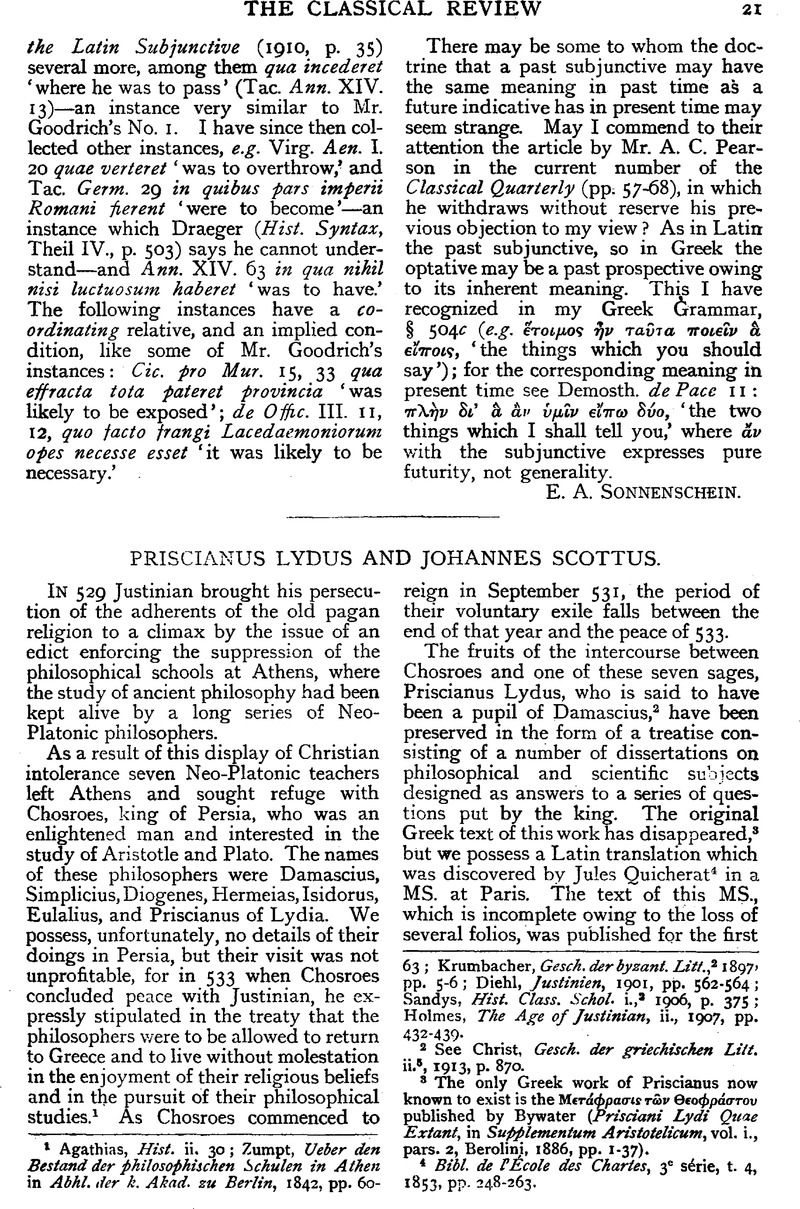Article contents
Priscianus Lydus and Johannes Scottus
Published online by Cambridge University Press: 27 October 2009
Abstract

Information
- Type
- Original Contributions
- Information
- Copyright
- Copyright © The Classical Association 1918
References
page 21 note 1 Agathias, , Hist. ii. 30Google Scholar; Zumpt, Ueber den Bestand der philosophischen Sckulen in Athen in Abhl. der k. Akad. zu Berlin, 1842, pp. 60—63 ; Krumbacher, , Gesch. derbyzant. Litt.,2 1897, pp. 5–6Google Scholar; Diehl, , Justinien, 1901, pp. 562–564Google Scholar; Sandys, Hist. Class. Schol. i.,2 1906, p. 375 ; Holmes, , The Age of Justinian, ii., 1907, pp. 432–439Google Scholar
page 21 note 2 See Christ, , Gesch. der griechischen Litt. ii.5, 1913, p. 870.Google Scholar
page 21 note 3 The only Greek work of Priscianus now known to exist is the ![]() published by Bywater (Prtsaani Lydi Quae Extant, in Supplementum Aristotelicum, vol. i., pars. 2, Berolini, 1886, pp. 1–37).
published by Bywater (Prtsaani Lydi Quae Extant, in Supplementum Aristotelicum, vol. i., pars. 2, Berolini, 1886, pp. 1–37).
page 21 note 4 Bibl. de I École des Chartes, 3e série, t. 4, 1853, pp. 248–263.
page 22 note 1 Plotini Enneades, Didot, 1855, pp. 555–579.
page 22 note 2 Arisloteles Pseudepigraphus, Lipsiae, 1863, pp. 338–341Google Scholar; and Anecdota Graeca et Graecolatina, i., Berlin, 1864, pp. 53–58.Google Scholar
page 22 note 3 Prisciani Lydi Quae Extant, pp. 41–104 ; cf. Jackson, , Ingram Bywater, 1917, pp. 96–98.Google Scholar
page 22 note 4 Loc. cit. supra, p. 253.
page 22 note 5 For an account of him cf. Esposito, , Studies, ii., 1913, p. 505.Google Scholar
page 22 note 6 Rand, Ap., Johannes Scottus, München, 1906, p. ix nGoogle Scholar. Traube offers no proof of his view, nor of his alternative suggestion that a certain Fergus of Saint-Amand may have been the translator.
page 22 note 7 Gesch. lat. Lit. des Mittelalters, i., 1911, PP. 331. 33.8.Google Scholar
page 22 note 8 Loc. cit. supra, p. xi. The Caroline period was suggested also by Usener (Rhein. Mus., N.F., 25, 1870, p. 607) and by Diels (Doxographi Graeci, 1879, P. 77).
page 22 note 9 Loc. cit, pp. 253–54.
page 22 note 10 Cf. Traube, , Mon. Germ. Hist., Poetae, iii., p. 522Google Scholar. In this work, published in 1896, Traube merely admitted that the translation may have been produced during the Caroline age.
page 22 note 11 For example, Dioscorides, Galen, Oribasius, Soranus, etc., cf. Teuffel, Gesch. röm. Lit.,5 1890, §§ 400, 463, 480, 483, 487. 489, 494, 498; Schanz, Gesch. röm. Lift., iv., 1904, pp. 273, 386.
page 22 note 12 I hope to deal with this question on a future occasion.
page 22 note 13 Cf. Manitius, , Gesch. der lat. Lit. des Mittelalters, I, pp. 678–689Google Scholar. To the works of Anastasius enumerated by Manitius must be added the Latin version of the Historia Mystica, attributed to S. Germanus of Constantinople, cf. Brightman, , Journ Theol. Studies, ix., 1908, pp. 249–250.Google Scholar
page 22 note 14 Manitius, loc. cit., pp. 682, 687.
page 23 note 1 The vocabulary supplies a large number of words not found in the Thesaurus Linguae Latinae, e.g. acherdos, affectabilis, animativus, cation, circulatiter, cognitivus, coinclinare, commoderatio, compassibilitas, compressura, concorrumpere, connaturaliter, connaturalitas, connebulatio, consummativus, contemperantia, disciplinatus (noun), factivus.
page 23 note 2 Bywater, ed., p. xi., Gemini Elementa Astronomiae, ed. Manitius, C., Lipsiae, 1898, pp. 250–251.Google Scholar
page 23 note 3 Cf. on the sources of the Solutiones, Diels, , Doxographi, pp. 77–78Google Scholar; Bywater, ed., p. xii.; Manitius, C., Geminus, pp. 239, 250.Google Scholar
page 23 note 4 In this connection it may be recalled that the Paris MS. is of the ninth century, and that Bywater (ed., p. x) has shown that it is not the original MS. of the translation but a copy. In the Bibliotheca Patrum Latinorum Britannica of Schenkl we are told (No. 2911) that MS. 103 of Emmanuel College, Cambridge, contains among other things Prisciani Physici Solutiones. This MS. has been missing from Cambridge for many years, but it is not lost as supposed by James (Western MSS. in Emmanuel College 1904, p. xiii) ; it is now in the British Museum as Harley 3969 (cf Esposito, , English Historical Review, xxx., 1915, p. 468).CrossRefGoogle Scholar
page 23 note 5 Cf. the De Praedestinatione and the versions of Dionysius and Maximus (Migne, Patrol. Lat., vol. 122).
- 4
- Cited by

